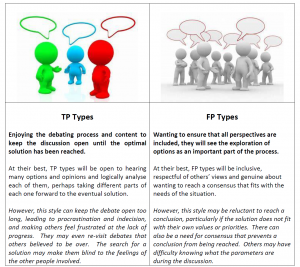7. How different types may try to Resolve Conflict
In previous articles we have explored:
- How different preferences and Types may perceive each other negatively or be misunderstood, resulting in conflict.
- How the Thinking-Feeling preference may influence our perception of what conflict actually is, and how we engage with it.
- How our stage of development can change our approach to conflict, and how being in conflict can cause us to regress to earlier stages, thus making the conflict situation even harder to resolve.
In this final article, I will describe how different Types may attempt to resolve a conflict situation. Once again, just the different approaches that we have due to our Types can make the conflcit worse if we get it wrong. I should mention here the work of Damian Killen and Danica Murphy who first brought this to my attention in their book Introduction to Type and Conflict.


Each Type has a style of resolving conflict that could be extremely effective if a degree of flexibility is exercised, but remember that in a conflict siutation we tend to become less flexible and open minded, so the ‘howevers’ shown in italics are here are very probable occurences if we, ourselves, are caught up in the conflict situation.
Of course, if two of the same Type are involved, their similarity in how they go about resolving conflict will probably lead to a satisfactory conclusion for them. But if different Types are involved, not only do we have different approaches to resolving the conflict to deal with, but there will also be either Opposing Function issues to deal with (see article 3) or Inferior Function issues (see article 4). So the situation could go completely pear shaped. (I don’t know why that is a phrase – personally speaking, I like the shape of pears….).
In their book, Damian and Danica suggest a process for conflict resolution that takes into account all four styles; in brief, create some space for discussion without rushing for closure, hear all views and understand the value of both the Thinking and Feeling perspectives, and then move towards finding a resolution.
So that’s the last in this series of articles. I will publish them soon in a book that will go into a bit more depth, have some illustrative case studies, and also contain the answer to the “so what do I do about it?” question. For those of you who work with Type, there will be some practical interventions and exercises for facilitating Conflict workshops. So keep a look out for the ‘as yet to be named’ book.
Earlier articles in this series of Different Perceptions of Conflict:
1. The difference in conflict definition from the Thinking and Feeling perspective
2a. Extraversion – Introversion explores common misunderstandings between these styles.
2b. Judging – Perceiving explores common misunderstandings between these styles
2c. The Functions – typical misperceptions between S and N, and T and F Types
3. The Potential for conflict from our Opposing Function
4. The Potential for conflict from our Inferior Function
5. The Potential for conflict between Same Types
6. The Potential for Conflict from the Perspective of Developmental Stage
